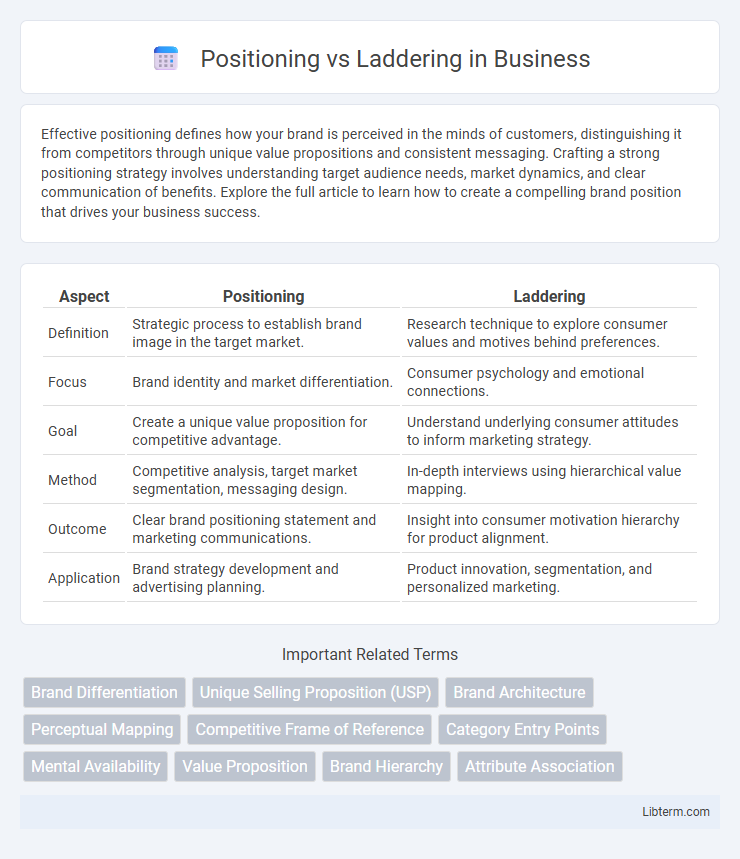Effective positioning defines how your brand is perceived in the minds of customers, distinguishing it from competitors through unique value propositions and consistent messaging. Crafting a strong positioning strategy involves understanding target audience needs, market dynamics, and clear communication of benefits. Explore the full article to learn how to create a compelling brand position that drives your business success.
Table of Comparison
| Aspect | Positioning | Laddering |
|---|---|---|
| Definition | Strategic process to establish brand image in the target market. | Research technique to explore consumer values and motives behind preferences. |
| Focus | Brand identity and market differentiation. | Consumer psychology and emotional connections. |
| Goal | Create a unique value proposition for competitive advantage. | Understand underlying consumer attitudes to inform marketing strategy. |
| Method | Competitive analysis, target market segmentation, messaging design. | In-depth interviews using hierarchical value mapping. |
| Outcome | Clear brand positioning statement and marketing communications. | Insight into consumer motivation hierarchy for product alignment. |
| Application | Brand strategy development and advertising planning. | Product innovation, segmentation, and personalized marketing. |
Understanding the Concepts: What is Positioning vs Laddering?
Positioning is a marketing strategy that establishes a brand's unique place in the consumer's mind by highlighting key attributes and differentiators against competitors. Laddering is a research technique used to uncover the underlying values and motivations that drive consumer behavior through a series of connected attribute-consequence-value linkages. Understanding positioning helps create distinct brand messaging, while laddering reveals emotional connections that inform deeper marketing insights.
Key Differences Between Positioning and Laddering
Positioning centers on defining a brand's unique place in the market by emphasizing distinct attributes and benefits that differentiate it from competitors. Laddering is a qualitative research technique that uncovers the deeper values and motivations behind consumer choices by linking product features to personal goals through a hierarchical means-end chain. The key difference lies in positioning's strategic market stance versus laddering's exploratory approach to understanding consumer psychology and value-driven decision-making.
The Origins and Evolution of Positioning
Positioning originated in the 1960s as a strategic marketing concept introduced by Al Ries and Jack Trout, emphasizing how brands occupy a distinct space in the consumer's mind relative to competitors. It evolved by incorporating psychological insights into consumer perception, enabling brands to craft unique value propositions and communicate them effectively. The development of positioning laid the groundwork for laddering techniques, which explore deeper consumer motivations behind brand preferences.
The Framework and Process of Laddering
Laddering is a qualitative research technique used to uncover the underlying values and motivations behind consumer choices by systematically probing from product attributes to functional consequences and finally to personal values. The laddering process involves repeated "why" questioning to reveal hierarchical connections between tangible features and abstract benefits, enabling marketers to build strong emotional brand positioning. In contrast to positioning, which defines a brand's unique place in the market, laddering offers a deep insight framework that informs the creation of effective, consumer-centric positioning strategies.
Benefits of Positioning in Brand Strategy
Positioning enhances brand differentiation by clearly defining a unique value proposition that resonates with target audiences, driving customer preference and loyalty. It strengthens competitive advantage through strategic market placement, enabling brands to occupy a distinct space in consumer minds. Effective positioning also streamlines marketing efforts, ensuring consistent messaging that maximizes brand recognition and recall.
Advantages of Laddering for Deep Consumer Insight
Laddering offers deep consumer insight by uncovering the meaningful connections between product attributes, benefits, and personal values, enabling marketers to understand the underlying motivations driving consumer behavior. This technique reveals the emotional and psychological factors behind purchase decisions, which positioning alone may overlook by focusing primarily on surface-level brand comparisons. By accessing these deeper layers, laddering facilitates the creation of highly targeted marketing strategies that resonate on a profound and personal level with consumers.
Practical Applications: When to Use Positioning or Laddering
Positioning is best used in marketing strategies to clearly define a brand's unique value and differentiate it from competitors in the minds of target consumers. Laddering is applied in consumer research to uncover deep motivations and emotional connections by linking product attributes to personal values through hierarchical questioning. Use positioning when crafting brand messaging and use laddering to gain insights for product development, advertising, and targeted communication.
Common Mistakes in Positioning and Laddering
Common mistakes in positioning include targeting overly broad audiences, leading to diluted brand messages, and failing to differentiate from competitors, which results in weak market presence. In laddering, errors often arise from superficial attribute analysis without uncovering deeper emotional values, causing incomplete consumer insights. Overlooking the connection between product features and personal benefits prevents effective positioning and diminishes the impact of marketing strategies.
Case Studies: Brands Winning with Positioning vs Laddering
Brands like Apple excel with positioning by clearly defining their identity around innovation and premium user experience, which creates strong emotional connections and brand loyalty. In contrast, Procter & Gamble's approach with laddering digs deeper into consumer values, linking product attributes to personal motivations, effectively driving purchase decisions on a functional and emotional level. Case studies reveal that positioning works best for market differentiation, while laddering excels in understanding and influencing consumer behavior.
Choosing the Right Approach: Positioning, Laddering, or Both?
Choosing the right approach between positioning and laddering depends on your marketing goals and customer insights. Positioning focuses on clearly defining a product or brand in the minds of target customers, emphasizing competitive differentiation and value propositions. Laddering delves deeper into consumer motivations by uncovering emotional and functional benefits through a hierarchical value chain, making a combined use valuable for comprehensive strategy development.
Positioning Infographic

 libterm.com
libterm.com